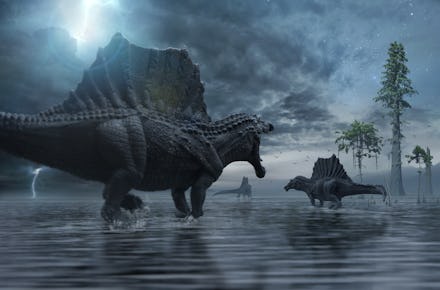A new Spinosaurus fossil completely changes our idea of how one of the largest dinosaurs lived

A newly discovered fossil could change the way paleontologists have modeled the Spinosaurus for decades. This gigantic, carnivorous creature is well known among dinosaur heads for the unique sail on its back and being a much larger predator than the Tyrannosaurus Rex. These characteristics were played up during its Hollywood moment in Jurassic Park 3, when the beast was turned into a rival for the series' iconic T. rex and a recurring antagonist for the main characters.
In the movie, the Spinosaurus could move through both land and water. This new finding, however, has put that popular depiction into question by revealing a very fish-like tail, indicating that the ancient creature was more marine-dwelling than once thought.
According to National Geographic, in 1912, German paleontologist Ernst Stromer named the partial skeleton of a dinosaur found in western Egypt the Spinosaurus. Due to the limited information about dinosaurs at the time, Stromer and other researchers depicted the animal as an enormous bipedal creature that lumbered on land with a short snout like other theropods (such as the T. rex). Later discoveries filled in some of the holes in that skeleton, revealing the Spinosaurus's long, crocodile-like snout and enormous size. Its body, for the most part, remained similar to other theropods, making it look like "an off-balance T.rex," noted National Geographic.
In 2014, ideas about its body shape changed thanks to a find by paleontologist Nizar Ibrahim. The spines on its back, his team believed, were actually more like a dorsal fin, and the shape of its teeth and elongated head suggested a diet that centered on fish. There were still a lot of unknowns about the tail, however, as well as how the body of the Spinosaurus helped it feed on fish. By then, models depicted it walking on all fours, its neck and head resting horizontally, as it used its legs to propel itself in water when it decided to take a dive every now and then for food.
This latest discovery has changed the Spinosaurus from a dinosaur that occasionally went into the water into a full-fledged aquatic beast. The newly found, fossilized bone fragments show a tail structure that was wide and flat, a body that leaned forward for balance in the water, and claws that were better suited for catching fish than gripping the ground. Unlike its land-dwelling cousins, the researchers believe that the Spinosaurus had a paddle-like tail that allowed it to move through the water with a side-to-side motion — almost like a fish.
"This was basically a dinosaur trying to build a fish tail," Ibrahim, the lead researcher examining the new fossil, told National Geographic.
To find these bones, Ibrahim had to race against fossil collectors — individuals who, he feared, would have kept the bones to themselves instead of offering them for study — to get to the dig sites first. His team worked through grueling conditions in the hopes of finding vertebrae from a skeleton and were finally rewarded with more than 30 Spinosaurus tail bones.
Through further study and modeling, researchers were able to get a clearer picture of how the Spinosaurus's tail worked. Scientists created a life-sized model of its tail, based on the bones, and put it to work in the water. The strength of its propulsion lent further evidence that Spinosaurus was more like a giant crocodile than a land-dwelling T. rex rival.
"This tail is unambiguous," paleontologist Samir Souhri, one of the research team members, told National Geographic. "This dinosaur was swimming."
It's a theory that's strengthened by the new discovery, much to the shock of other scientists.
"This is certainly a bit of a surprise," paleontologist Tom Holtz, who wasn't involved with the research team, told National Geographic. "Spinosaurus is even weirder than we thought it was."